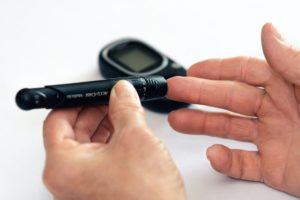 The unprecedented Coronavirus disease 2019 (COVID-19) pandemic has caused considerable loss of lives, health and psychosocial issues, as well as economic ramifications globally. As of 31st of January 2021, there are 102 million confirmed cases with 2.2 million deaths, as reported by the World Health Organization. Malaysia reported a new record high number of newly confirmed cases at 5,728 on the 30th of January 2021.
The unprecedented Coronavirus disease 2019 (COVID-19) pandemic has caused considerable loss of lives, health and psychosocial issues, as well as economic ramifications globally. As of 31st of January 2021, there are 102 million confirmed cases with 2.2 million deaths, as reported by the World Health Organization. Malaysia reported a new record high number of newly confirmed cases at 5,728 on the 30th of January 2021.
Meanwhile, about one in every five (18.3%) Malaysian adults have diabetes, translating to a staggering 3.9 million people. One recent observation that captures many clinicians and public health practitioners’ attention is the bidirectional relationship between diabetes and COVID-19. On the one hand, data have shown us that diabetes patients have more severe COVID-19 and increased mortality than those without diabetes. An unusually high number of COVID-19 patients with diabetes developed hyperglycaemic hyperosmolar syndromes and diabetic ketoacidosis, where the mortality rate was high. Besides that, poor glycosylated A1C control is an independent predictor for COVID-19 deaths.
On the other hand, there is emerging evidence that SARS-CoV-2 could induce new-onset diabetes. SARS-CoV-2 spike proteins bind to angiotensin-converting-enzyme 2 (ACE2) receptors, particularly those on pancreatic beta cells, potentially causing damages leading to insulin deficiency. In the UK, an 80% increase in new-onset type 1 diabetes was observed during this pandemic compared to a typical year. Although the authors could not prove a causal link, they postulated that SARS-CoV-2 exposure might precipitate or accelerate type 1 diabetes onset using the ACE2 receptor pathway. The bidirectional relationship between diabetes and COVID-19 led an international group of diabetes experts to launch a global registry of COVID-19-related diabetes (CoviDiab Registry).
Besides that, early screening and diagnosis of diabetes, control of cardiovascular risk factors among diabetes patients and long-term diabetes complications must not be overlooked.
 The routine screening and early diagnosis of diabetes (especially those without symptoms) may be disrupted as health resources are redistributed from preventive to acute care of COVID-19. This is a possible situation considering that some recommendations suggested deferring routine appointments where diabetes is stable and when the risk of attending an appointment is greater than the benefits.
The routine screening and early diagnosis of diabetes (especially those without symptoms) may be disrupted as health resources are redistributed from preventive to acute care of COVID-19. This is a possible situation considering that some recommendations suggested deferring routine appointments where diabetes is stable and when the risk of attending an appointment is greater than the benefits.
Optimisation of A1C, blood pressure and cholesterol control become even more important as a mean for primary prevention of COVID-19 infection. The paradox here is that this pandemic makes optimal metabolic control more difficult due to interruption of routine healthcare and changes in diabetes self-care (e.g., inadequate blood glucose test strips and less exercising due to stay-at-home orders or quarantine).
Previous studies have demonstrated legacy effects where early and tight glycaemic control reduced microvascular and macrovascular complications, including deaths. Hence, delayed diagnosis and management of new diabetes patients, coupled with more inadequate metabolic control among known diabetes patients (also potentially new COVID-19-induced diabetes) can inadvertently increase the burden of diabetes complications over the long term.
In public health management of diabetes during this pandemic, we need to be dynamic, continually monitoring COVID-19 situation and our available resources. With the pandemic currently showing no sign of abating, we may need to re-strategise and play the ‘loser game’, e.g., minimising disruption of health services and using telemedicine to maintain some contact with diabetes patients. Once the COVID-19 situation improves, we should restart preventive programmes judiciously such as screening for diabetes in the community. Besides that, follow-up of recovered COVID-19 patients is important to monitor long-term complications of the disease. One practical way for this surveillance activity is to join an established registry such as the CoviDiab Registry.
Written by:
Professor Dr Noran Naqiah Hairi, Professor Dr Moy Foong Ming and Dr Wan Kim Sui
Centre for Epidemiology and Evidence-Based Practice, Department of Social and Preventive Medicine, Faculty of Medicine, University of Malaya.
References
- World Health Organization. WHO Coronavirus Disease (COVID-19) Dashboard. https://covid19.who.int/ Updated January 31, 2021. Accessed February 1, 2021.
- World Health Organization. Malaysia situation. WHO Coronavirus Disease (COVID-19) Dashboard. https://covid19.who.int/region/wpro/country/my Updated January 31, 2021. Accessed February 1, 2021.
- Institute for Public Health. National Health and Morbidity Survey (NHMS) 2019: Vol 1: NCDs – Non-communicable Diseases: Risk Factors and other Health Problems. Selangor, Malaysia. 2020.
- Holman N, Knighton P, Kar P, et al. Risk factors for COVID-19-related mortality in people with type 1 and type 2 diabetes in England: a population-based cohort study. The lancet Diabetes & endocrinology. 2020;8(10):823-833.
- Singh AK, Khunti K. Assessment of risk, severity, mortality, glycemic control and antidiabetic agents in patients with diabetes and COVID-19: A Narrative Review. Diabetes Res Clin Pract.
- Li J, Wang X, Chen J, Zuo X, Zhang H, Deng A. COVID-19 infection may cause ketosis and ketoacidosis. Diabetes Obes Metab.
- Rayman G, Lumb A, Kennon B, et al. Guidance on the management of Diabetic Ketoacidosis in the exceptional circumstances of the COVID‐19 pandemic. Diabet Med.
- Unsworth R, Wallace S, Oliver NS, et al. New-Onset Type 1 Diabetes in Children During COVID-19: Multicenter Regional Findings in the U.K. Diabetes Care. 2020;43(11):e170-e171.
- Diabetes TL. COVID-19 and diabetes: a co-conspiracy? The lancet Diabetes & Endocrinology. 2020;8(10):801.
- Bornstein SR, Rubino F, Khunti K, et al. Practical recommendations for the management of diabetes in patients with COVID-19. The lancet Diabetes & endocrinology.
- Holman RR, Paul SK, Bethel MA, Matthews DR, Neil HAW. 10-year follow-up of intensive glucose control in type 2 diabetes. N Engl J Med. 2008;359(15):1577-1589.
- Laiteerapong N, Ham SA, Gao Y, et al. The legacy effect in type 2 diabetes: impact of early glycemic control on future complications (the Diabetes & Aging Study). Diabetes Care. 2019;42(3):416-426.
[This article belongs to The Malaysian Medical Gazette. Any republication (online or offline) without written permission from The Malaysian Medical Gazette is prohibited.]
